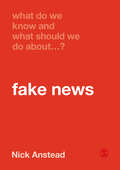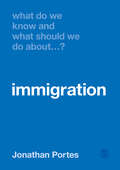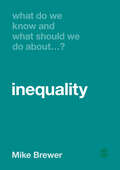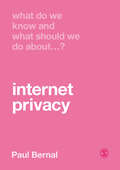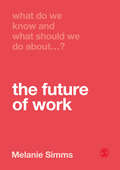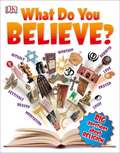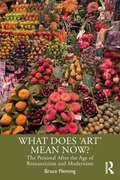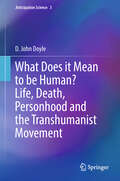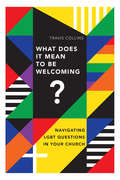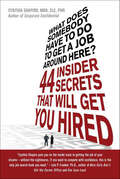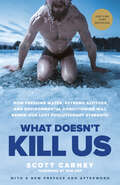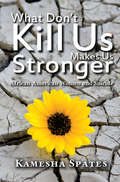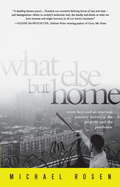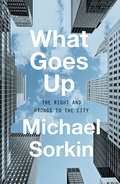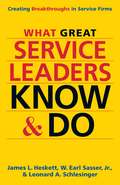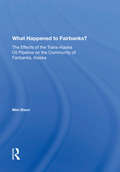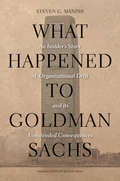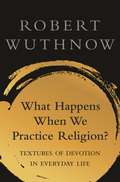- Table View
- List View
What Do We Know and What Should We Do About Fake News? (What Do We Know and What Should We Do About:)
by Nick AnsteadVoters need to be informed to make political decisions, but what if their media diet not only prevents them from getting the information they need, but actively shapes inaccurate perceptions of the world? Drawing on examples and evidence from around the world, this book aims to make a timely intervention to the debate about the concept of fake news. Its underlying argument will have three objectives. First, to offer more precise definitions for a term that is often loosely used. Second, to offer a less technologically determinist view of fake news. New social media platforms, such as Facebook and WhatsApp, are clearly an important part of the story, but they exist in wider social, political and institutional settings. Third, to situate the idea of fake news (and our concern about it) in broader arguments about an ongoing crisis and loss of confidence in liberal democratic institutions. Only with this perspective, it will be argued, can we possibly address the question of what we should do about fake news.
What Do We Know and What Should We Do About Fake News? (What Do We Know and What Should We Do About:)
by Nick AnsteadVoters need to be informed to make political decisions, but what if their media diet not only prevents them from getting the information they need, but actively shapes inaccurate perceptions of the world? Drawing on examples and evidence from around the world, this book aims to make a timely intervention to the debate about the concept of fake news. Its underlying argument will have three objectives. First, to offer more precise definitions for a term that is often loosely used. Second, to offer a less technologically determinist view of fake news. New social media platforms, such as Facebook and WhatsApp, are clearly an important part of the story, but they exist in wider social, political and institutional settings. Third, to situate the idea of fake news (and our concern about it) in broader arguments about an ongoing crisis and loss of confidence in liberal democratic institutions. Only with this perspective, it will be argued, can we possibly address the question of what we should do about fake news.
What Do We Know and What Should We Do About Immigration? (What Do We Know and What Should We Do About:)
by Jonathan PortesWhat Do We Know and What Should We Do About Immigration? Is part of a new book series offering short, up-to-date overviews of key issues often misrepresented or simplified in the mainstream media. In this book, Professor Jonathan Portes examines the subject of immigration, providing readers with a short history of immigration in the UK, followed by a detailed discussion of ‘What We Know’ about the economic and social impact of immigration. Portes addresses commonly asked questions such as: Does immigration reduce job opportunities for those born in the UK, or push down wages? What is the impact of immigration on the public finances and public services? What has the impact of free movement of people been, both in the UK and the rest of the EU? The author concludes by suggesting ‘What We Should Do” about immigration, investigating what a post-Brexit immigration system should look like, and what – if anything – do we need to promote integration? Intended for anyone seeking a quick and authoritative understanding of immigration in the UK. Series Editor: Professor Chris Grey, Royal Holloway, University of London
What Do We Know and What Should We Do About Immigration? (What Do We Know and What Should We Do About:)
by Jonathan PortesWhat Do We Know and What Should We Do About Immigration? Is part of a new book series offering short, up-to-date overviews of key issues often misrepresented or simplified in the mainstream media. In this book, Professor Jonathan Portes examines the subject of immigration, providing readers with a short history of immigration in the UK, followed by a detailed discussion of ‘What We Know’ about the economic and social impact of immigration. Portes addresses commonly asked questions such as: Does immigration reduce job opportunities for those born in the UK, or push down wages? What is the impact of immigration on the public finances and public services? What has the impact of free movement of people been, both in the UK and the rest of the EU? The author concludes by suggesting ‘What We Should Do” about immigration, investigating what a post-Brexit immigration system should look like, and what – if anything – do we need to promote integration? Intended for anyone seeking a quick and authoritative understanding of immigration in the UK. Series Editor: Professor Chris Grey, Royal Holloway, University of London
What Do We Know and What Should We Do About Inequality? (What Do We Know and What Should We Do About:)
by Professor Mike BrewerWhat Do We Know and What Should We Do About Inequality? is part of a new book series offering short, up-to-date overviews of key issues often misrepresented or simplified in the mainstream media. In this book, Professor Mike Brewer discusses "What We Know" about economic inequalities in the UK, presenting new analysis of the top 1% and 0.1% in the UK, and summarising the causes and consequences of high levels of inequality. Brewer answers the following questions: Why is curbing inequality now regarded as a global challenge? Why did the UK become more unequal during the 1980s? What has happened to incomes since the financial crash in 2008 and the government austerity that followed? How relevant is Thomas Piketty's prediction that growing wealth inequalities will return us to levels of inequality last seen at the dawn of the twentieth century? The author concludes by suggesting "What We Should Do" to move the UK off its high-inequality path, including further taxation, wealth redistribution and welfare reform. Intended for anyone seeking a quick and authoritative understanding of inequality in the modern era. Series Editor: Professor Chris Grey, Royal Holloway, University of London
What Do We Know and What Should We Do About Inequality? (What Do We Know and What Should We Do About:)
by Professor Mike BrewerWhat Do We Know and What Should We Do About Inequality? is part of a new book series offering short, up-to-date overviews of key issues often misrepresented or simplified in the mainstream media. In this book, Professor Mike Brewer discusses "What We Know" about economic inequalities in the UK, presenting new analysis of the top 1% and 0.1% in the UK, and summarising the causes and consequences of high levels of inequality. Brewer answers the following questions: Why is curbing inequality now regarded as a global challenge? Why did the UK become more unequal during the 1980s? What has happened to incomes since the financial crash in 2008 and the government austerity that followed? How relevant is Thomas Piketty's prediction that growing wealth inequalities will return us to levels of inequality last seen at the dawn of the twentieth century? The author concludes by suggesting "What We Should Do" to move the UK off its high-inequality path, including further taxation, wealth redistribution and welfare reform. Intended for anyone seeking a quick and authoritative understanding of inequality in the modern era. Series Editor: Professor Chris Grey, Royal Holloway, University of London
What Do We Know and What Should We Do About Internet Privacy? (What Do We Know and What Should We Do About:)
by Paul BernalPrivacy on the internet is challenged in a wide variety of ways - from large social media companies, whose entire business models are based on privacy invasion, through the developing technologies of facial recognition, to the desire of governments to monitor our every activity online. But the impact these issues have on our daily lives is often underplayed or misunderstood. In this book, Paul Bernal analyses how the internet became what it is today, exploring how the current manifestation of the internet works for people, for companies and even for governments, with reference to the new privacy battlefields of location and health data, the internet of things and the increasingly contentious issue of personal data and political manipulation. The author then proposes what we should do about the problems surrounding internet privacy, such as significant changes in government policy, a reversal of the current ‘war’ on encryption, being brave enough to take on the internet giants, and challenging the idea that ‘real names’ would improve the discourse on social networks. ABOUT THE SERIES: The ‘What Do We Know and What Should We Do About...?′ series offers readers short, up-to-date overviews of key issues often misrepresented, simplified or misunderstood in modern society and the media. Each book is written by a leading social scientist with an established reputation in the relevant subject area. The Series Editor is Professor Chris Grey, Royal Holloway, University of London
What Do We Know and What Should We Do About Internet Privacy? (What Do We Know and What Should We Do About:)
by Paul BernalPrivacy on the internet is challenged in a wide variety of ways - from large social media companies, whose entire business models are based on privacy invasion, through the developing technologies of facial recognition, to the desire of governments to monitor our every activity online. But the impact these issues have on our daily lives is often underplayed or misunderstood. In this book, Paul Bernal analyses how the internet became what it is today, exploring how the current manifestation of the internet works for people, for companies and even for governments, with reference to the new privacy battlefields of location and health data, the internet of things and the increasingly contentious issue of personal data and political manipulation. The author then proposes what we should do about the problems surrounding internet privacy, such as significant changes in government policy, a reversal of the current ‘war’ on encryption, being brave enough to take on the internet giants, and challenging the idea that ‘real names’ would improve the discourse on social networks. ABOUT THE SERIES: The ‘What Do We Know and What Should We Do About...?′ series offers readers short, up-to-date overviews of key issues often misrepresented, simplified or misunderstood in modern society and the media. Each book is written by a leading social scientist with an established reputation in the relevant subject area. The Series Editor is Professor Chris Grey, Royal Holloway, University of London
What Do We Know and What Should We Do About the Future of Work? (What Do We Know and What Should We Do About:)
by Melanie SimmsWhat Do We Know and What Should We Do About The Future of Work? is part of a new book series offering short, up-to-date overviews of key issues often misrepresented or simplified in the mainstream media. In this book, Professor Melanie Simms analyses ‘What We Know’ about the current state of paid employment in the UK and provides a far-ranging examination of the most pressing issues facing traditional employment, such as: The rise of automation Robotics and artificial intelligence Platform capitalism The Universal Basic Income The challenges of demographic change The author concludes by suggesting ‘What We Should Do' – identifying four main areas that would have to be strengthened, in order to deliver a society and economy with more and better jobs. Intended for anyone seeking a quick and authoritative understanding of the future of work in the UK. Series Editor: Professor Chris Grey, Royal Holloway, University of London
What Do We Know and What Should We Do About the Future of Work? (What Do We Know and What Should We Do About:)
by Melanie SimmsWhat Do We Know and What Should We Do About The Future of Work? is part of a new book series offering short, up-to-date overviews of key issues often misrepresented or simplified in the mainstream media. In this book, Professor Melanie Simms analyses ‘What We Know’ about the current state of paid employment in the UK and provides a far-ranging examination of the most pressing issues facing traditional employment, such as: The rise of automation Robotics and artificial intelligence Platform capitalism The Universal Basic Income The challenges of demographic change The author concludes by suggesting ‘What We Should Do' – identifying four main areas that would have to be strengthened, in order to deliver a society and economy with more and better jobs. Intended for anyone seeking a quick and authoritative understanding of the future of work in the UK. Series Editor: Professor Chris Grey, Royal Holloway, University of London
What Do You Believe? (Big Questions)
by Dorling Kindersley Publishing StaffReligion, morality, science, and the afterlife are complex and often misunderstood subjects. What Do You Believe? is a dynamic and clear text that brings together a variety of ideas of on religion. They are clearly presented for children to understand in a clear, unbiased text, and key concepts are broken down into manageable chunks of information with keywords that are simply explained. What Do You Believe? looks at basic teachings, practices of world faiths, philosophy, and more, and delves into the meaning and purpose of life. This book promotes understanding, tolerance, and respect for people whatever they believe.
What Does ‘Art’ Mean Now?: The Personal After the Age of Romanticism and Modernism
by Bruce FlemingWhat Does ‘Art’ Mean Now? asks, and answers, fundamental questions about the nature of aesthetic experience and role of the arts in contemporary society. The Modern Age, Romanticism and beyond, viewed art as something transcending and separated from life, and usually something encountered in museums or classrooms. Nowadays, however, art tends to be defined not by a commonly agreed-upon standard of “quality” or by its forms, such as painting and sculpture, but instead by political and ideological criteria. So how do we connect with the works in museums whose point was precisely that they stood apart from such considerations? Can we and should we be educated to “appreciate” art—and what does it do for us anyway? What are we to make of the so-different newer works—installations, performances, excerpts from the world—held to be art that increasingly make it into museums? Adopting a subjectivist approach, this book argues that in the absence of a universal judgment or standard of taste, the experience of art is one of freedom. The arts give us the means to conceptualize our lives, showing us ourselves as we are and as we might wish—or not wish—to be, as well as where we have been and where we are going. It will appeal to scholars of sociology, philosophy, museum studies, and art history, and to anyone interested in, or puzzled by, museums or college courses and their presentation of art today.
What Does it Mean to be Human? Life, Death, Personhood and the Transhumanist Movement (Anticipation Science #3)
by D. John DoyleThis book is a critical examination of the philosophical and moral issues in relation to human enhancement and the various related medical developments that are now rapidly moving from the laboratory into the clinical realm. In the book, the author critically examines technologies such as genetic engineering, neural implants, pharmacologic enhancement, and cryonic suspension from transhumanist and bioconservative positions, focusing primarily on moral issues and what it means to be a human in a setting where technological interventions sometimes impact strongly on our humanity. The author also introduces the notion that death is a process rather than an event, as well as identifies philosophical and clinical limitations in the contemporary determination of brain death as a precursor to organ procurement for transplantation. The discussion on what exactly it means to be dead is later applied to explore philosophical and clinical issues germane to the cryonics movement. Written by a physician/ scientist and heavily referenced to the peer-reviewed medical and scientific literature, the book is aimed at advanced students and academics but should be readable by any intelligent reader willing to carry out some side-reading. No prior knowledge of moral philosophy is assumed, as the various key approaches to moral philosophy are outlined early in the book.
What Does It Mean to Be Welcoming?: Navigating LGBT Questions in Your Church
by Travis Collins16th Annual Outreach Magazine Resource of the Year - Social Issues/JusticeWhat Does It Mean to Be Welcoming?
What Does Somebody Have to Do to Get a Job Around Here?: 44 Insider Secrets That Will Get You Hired
by Cynthia ShapiroIf you are looking for a job you need every advantage you can get. What Does Somebody Have to Do to Get a Job Around Here? puts a former Human Resources executive turned employee advocate in your corner. Cynthia Shapiro reveals the best-kept job secrets that employers don't want you to know including:*Secret #8: A computer is deciding your job prospects.*Secret #12: Professional references are useless.*Secret #18: There is a "type" that always gets the offer.*Secret #21: The Thank-You note is too late.*Secret #28: Always negotiate.* …and thirty-nine more!Once you know the secrets you can create a winning resume, ace the interview, and land the job of your dreams.
What Doesn't Kill Us: How Freezing Water, Extreme Altitude, and Environmental Conditioning Will Renew Our Lost Evolutionary Strength
by Scott CarneyWhat Doesn't Kill Us, a New York Times bestseller, traces our evolutionary journey back to a time when survival depended on how well we adapted to the environment around us. Our ancestors crossed deserts, mountains, and oceans without even a whisper of what anyone today might consider modern technology. Those feats of endurance now seem impossible in an age where we take comfort for granted. But what if we could regain some of our lost evolutionary strength by simulating the environmental conditions of our ancestors? Investigative journalist and anthropologist Scott Carney takes up the challenge to find out: Can we hack our bodies and use the environment to stimulate our inner biology? Helping him in his search for the answers is Dutch fitness guru Wim Hof, whose ability to control his body temperature in extreme cold has sparked a whirlwind of scientific study. Carney also enlists input from an Army scientist, a world-famous surfer, the founders of an obstacle course race movement, and ordinary people who have documented how they have cured autoimmune diseases, lost weight, and reversed diabetes. In the process, he chronicles his own transformational journey as he pushes his body and mind to the edge of endurance, a quest that culminates in a record-bending, 28-hour climb to the snowy peak of Mt. Kilimanjaro wearing nothing but a pair of running shorts and sneakers.An ambitious blend of investigative reporting and participatory journalism, What Doesn’t Kill Us explores the true connection between the mind and the body and reveals the science that allows us to push past our perceived limitations.
What Don't Kill Us Makes Us Stronger: African American Women and Suicide (New Critical Viewpoints On Society Ser.)
by Kamesha SpatesA close look at black women’s physical, mental, and social circumstances reveals harmful social disparities. Yet, for decades, black women’s suicide rates have remained virtually nonexistent compared to the rest of the American population, baffling social scientists. In this book, black women speak for themselves about their life struggles and their notions of suicide. Within a framework that explores racial and gender inequalities, Spates uses interviews to uncover reasons for the racial suicide paradox. Her analysis offers a deeper understanding of the positive life strategies, including family and faith, that underlie black women’s resilience. -Provides insights into the impact of a variety of racial and gender inequalities-Vivid use of qualitative approaches to shed light on a statistical paradox-Highlights a positive image of black women and their resilience
What Drives Household Borrowing and Credit Constraints? Evidence from Bosnia and Herzegovina
by Ke Chen Chen Mali ChivakulA report from the International Monetary Fund.
What Else But Home: Seven Boys and an American Journey Between the Projects and the Penthouse
by Michael RosenA compelling story of one familyOCOs journey across the divide of race, class, and economic opportunity in America through love and baseball"
What Goes Up: The Right and Wrongs to the City
by Michael SorkinA radical architect examines the changing fortunes of the contemporary cityMichael Sorkin is one of the most forthright and engaging architectural writers in the world. In What Goes Up he takes to task the public officials, developers, “civic” organizations, and other heroes of big money, who have made of Sorkin’s beloved New York a city of glittering towers and increasing inequality. He unpacks not simply the forms and practices—from zoning and political deals to the finer points of architectural design—that shape cities today but also offers spirited advocacy for another kind of city, reimagined from the street up on a human scale, a home to sustainable, just, and fulfilling neighborhoods and public spaces. Informing his writing is a lifetime’s experience as an architect and urbanist. Sorkin writes of the joys and techniques of observing and inhabiting cities and buildings in order to both better understand and to more happily be in them. Sorkin has never been shy about naming names. He has been a scourge of design mediocrity and of the supine compliance of “starchitects,” who readily accede to the demands of greed and privilege. What Goes Up casts the net wide, as he directs his arguments to students, professionals, and urban citizens with vigor, expertise, respect, and barbed wit.
What Great Service Leaders Know and Do
by Leonard A. Schlesinger W. Earl Sasser Jr. James L. HeskettEntire service businesses have been built around the ideas of Heskett, Sasser, and Schlesinger, pioneers in the world of service. Now they test their ideas against the actual experiences of successful and unsuccessful practitioners, as well as against demands of the future, in a book service leaders around the world will use as a guide for years to come. The authors cover every aspect of optimal service leadership: the best hiring, training, and workplace organization practices; the creation of operating strategies around areas such as facility design, capacity planning, queue management, and more; the use--and misuse--of technology in delivering top-level service; and practices that can transform loyal customers into "owners."Looking ahead, the authors describe the world of great service leaders in which "both/and" thinking replaces trade-offs. It's a world in which new ideas will be tested against the sine qua non of the "service trifecta"--wins for employees, customers, and investors. And it's a world in which the best leaders admit that they don't have the answers and create organizations that learn, innovate, "sense and respond," operate with fluid boundaries, and seek and achieve repeated strategic success.Using examples of dozens of companies in a wide variety of industries, such as Apollo Hospitals, Châteauform, Starbucks, Amazon, Disney, Progressive Insurance, the Dallas Mavericks, Whole Foods, IKEA, and many others, the authors present a narrative of remarkable successes, unnecessary failures, and future promise.
What Happened To Fairbanks?: The Effects Of The Trans-alaska Oil Pipeline On The Community Of Fairbanks, Alaska
by Mim DixonThis book describes what Fairbanks was like during trans-Alaska oil pipeline construction and how the community responded to the project, and assesses the unplanned negative effects that, in many cases, outweighed the positive ones.
What Happened to Goldman Sachs
by Steven G. MandisThis is the story of the slow evolution of Goldman Sachs-addressing why and how the firm changed from an ethical standard to a legal one as it grew to be a leading global corporation.In What Happened to Goldman Sachs, Steven G. Mandis uncovers the forces behind what he calls Goldman's "organizational drift." Drawing from his firsthand experience; sociological research; analysis of SEC, congressional, and other filings; and a wide array of interviews with former clients, detractors, and current and former partners, Mandis uncovers the pressures that forced Goldman to slowly drift away from the very principles on which its reputation was built.Mandis evaluates what made Goldman Sachs so successful in the first place, how it responded to pressures to grow, why it moved away from the values and partnership culture that sustained it for so many years, what forces accelerated this drift, and why insiders can't-or won't-recognize this crucial change.Combining insightful analysis with engaging storytelling, Mandis has written an insider's history that offers invaluable perspectives to business leaders interested in understanding and managing organizational drift in their own firms.
What Happens When We Practice Religion?: Textures of Devotion in Everyday Life
by Robert WuthnowAn exploration of the interdisciplinary methods used to understand religious practiceReligion is commonly viewed as something that people practice, whether in the presence of others or alone. But what do we mean exactly by "practice"? What approaches help to answer this question? What Happens When We Practice Religion? delves into the central concepts, arguments, and tools used to understand religion today.Throughout the past few decades, the study of religion has shifted away from essentialist arguments that grandly purport to explain what religion is and why it exists. Instead, using methods from anthropology, psychology, religious studies, and sociology, scholars now focus on what people do and say: their daily religious habits, routines, improvisations, and adaptations. Robert Wuthnow shows how four intersecting areas of inquiry—situations, intentions, feelings, and bodies—shed important light on religious practice, and he explores such topics as the role of religious experiences in sacred spaces, gendered social relationships, educational settings, the arts, meditation, and ritual.Suitable for undergraduate and graduate courses, What Happens When We Practice Religion? provides insights into the diverse ways that religion manifests in ordinary life.Summarizes the latest theories and empirical methods of religious practiceShows how the study of religion has changedIncludes chapters on theory, situations, intentions, feelings, and bodiesDraws from anthropology, psychology, religious studies, and sociologyAccessible for undergraduate and graduate courses
